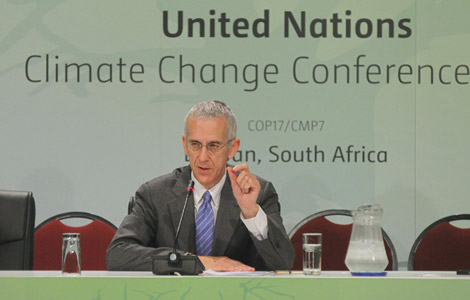ADB cuts Philippine growth forecast to 3.7%
Updated: 2011-12-06 13:30
(Xinhua)
|
|||||||||||
MANILA - The Asian Development Bank (ADB) downgraded its growth forecast for the Philippines this year to 3.7 percent on back of a global slowdown.
According to the latest Asia Economic Monitor (AEM) issued Tuesday, the debt crisis in Europe and the US fiscal problems will hurt the Philippines and other East Asian economies.
"The turmoil emanating from Europe poses a growing danger to trade and finance within emerging East Asia; so the region's policymakers must be prepared to act promptly, decisively, and collectively to counter what could be an extended global economic slowdown," ADB Office of Regional Economic Integration Head Iwan J. Azis said.
The ADB earlier forecast Philippine economy to grow 4.7 percent this year.
The AEM also noted that if the Eurozone and the US were to fall into a deep recession next year, the Philippine GDP growth would be 0.6 percentage points slower at 4.2 percent. It can be noted that ADB's initial forecast for Philippine economic growth were at 4.7 percent this year and 5.1 percent in 2012.
The ADB downgraded its forecast for the region's growth in 2012 to 7.2 percent from the 7.5 percent forecast in the September Asian Development Outlook 2011 Update. The region's Gross Domestic Product growth was still forecast to hit 7.5 percent for this year.
The ADB said that if the European and US economies contracted as much as they did in 2009 - emerging East Asia would grow by 5.4 percent next year. That would only be 1.8 percentage points below the current forecast but not as severe as the impact of the 2008-2009 global crisis. This, the ADB said, is due to the diversification of the region's export markets and increased domestic demand as a source of growth.
However, the Manila-based multilateral development bank noted that the region's financial systems remain as vulnerable as they were in 2008. The report noted that the heightened risk aversion would see investors slash holdings of Asian financial assets while highly leveraged European banks would cut lending, leading to tighter credit conditions.
Hot Topics
HIV/AIDS, Egypt protest, Thanksgiving, climate change, global economic recovery, home prices, high-speed railways, school bus safety, Libya situation, Weekly photos
Editor's Picks

|

|

|

|

|

|







